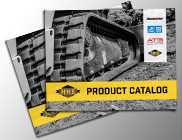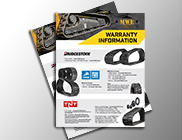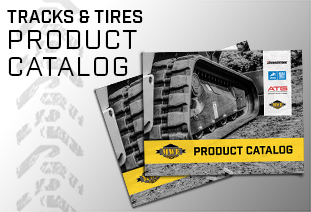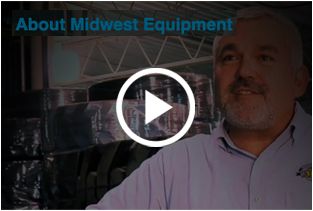Skid Steer Tire Maintenance and Wheel Care Tips

Tracks And Tires would like to share with you a few safety and maintenance tips to help enhance the service life of your wheels and tires. Without the proper care and maintenance, this may reduce the service life of any Skid Steer Wheel or Tire.
Maintenance And Use
- The wheels / tires and applications indicated on this website are intended as a guide only for typical applications; Please contact our representative for verification for your specific use.
- Any tire(s) sizes indicated on this website are related to the possibility to mount the tire(s) on the rim(s) according to ETRTO, TRA, and JATMA standards only and are not an indication to wheel / capacity compatibility.
- It is your responsibility to check the load/speed indices for the individual products with the manufacturer, and to ensure that each component suits your needs.
- Any information on this website is merely indicative and can be changed without notice or notification.
- Always use clearly identified wheels/components and tires.
- Always verify that the wheels and tires are compatible with your machine.
- Always ensure that the correct axle wheels studs/nuts and washers are use to locate the wheel on to the axle. A list of common wheel stud hole dimensions can be obtained through our representatives.
- To ensure the best alignment, wheel studs and nuts should be cross fixed when fitting the wheel to the axle hub.
- Always ensure the wheel nuts are torqued to the correct settings, using the appropriate tool, such as a toque wrench. We recommend to check the torque settings after the first 50km.
- The incorrect use / fitting of components on multi piece and divided wheels can result in wheel failure. Mounting and removal of wheels and tires should only be preformed by trained professionals.
- When lubricating tire bead, only use neutral, non aggressive mounting pastes according to tire manufactures recommendations (grease for PON fitting, quick drying soap for solids and paste for pneumatics).
- Tire fills influence the strength of the wheel; please advise us if you use tire fill.
- Always ensure that the tires are fully deflated before removing the wheel or it’s components from a vehicle, especially multi piece and divided wheels.
- Prior to inflation or deflation, the components on multi piece wheels should always be carefully checked for correct fitment and positioning. Never try to place / remove components with the use of force.
- Deformed, corroded or damaged components must be replaced.
- In case of incorrect fitment, demount the components and restart the mounting procedure.
- Wheel studs, nuts or washers that show indication of oxidation, or can not be used must be replaced, do not grease or oil.
- We recommend periodical checks of the wheels/rims for cracking and corrosion, particular attention should be paid to the shaping radius, value hole and stud hole areas. If cracking occurs, replace the wheel. DO NOT TRY TO WELD ANY CRACKS.
- Oxidation and/or paint scratches should be cleaned, treated and repainted.
- Wheels are designed for slow moving earthmover and industrial applications up to 50 km/h.
Important Safety Warning For Lock Rings
- Always check all bolts and nuts for damage on the thread before assembling the new wheel.
- Never exceed the air pressure guaranteed for split wheels (note: standards can vary from one wheel to the other).
- Change to a lock ring wheel if the recommended tire pressure is greater than the split wheel guaranteed pressure.
- The inflation / deflation of multi piece and divided wheels must only be carried out by fully trained and authorized personnel who should follow exactly the instructions provided by the wheel and tire manufactures. Safety cages and bars must be used in all applications in conjunction with remote inflation gauges.
- All types of bolts must always be fitted to the outside, not toward the machine side. Hexagonal bolts can only be used for solid tires, not for pnematics.
Tire Mounting – Multi Piece And Divided Wheels
- Please be sure all components are correct, suitable, free from damage and clear of debris.
- With the tire mounted on the rim inflation should be done in two stages.
- First makes sure the tire beads and components are correctly seated and centered, inflate the tire to 1.5 bar. – Inspect the units for deformations, blisters and seating / security of the components.
- Second, place the wheel and tire in to a suitable safety cage and inflate to the require pressure.
NOTE: We recommend that inflation of DIVIDED wheels should not exceed 2.0 bar until it has been fitted to it’s axle hub and secured accordingly.
Skid Steer Tire Care And Maintenance Tips
- Customers should always check the load/speed indices for tires, wheels and their components. If unsure, always check with the tire and/or wheel manufacturer for their recommendations.
- The correct use/fitting of components on construction wheels can result in wheel failure. Mounting and removal of wheels and tires should only be performed by trained personnel.
- Always ensure that the tires are fully deflated (by removing the valve core completely) before removing the wheel or it’s components from your machine, especially for multi-piece construction wheels. Avoid standing in front of construction wheels during assembly: loose components that might spring off if damaged.
- Prior to inflation and deflation, the components of construction wheels should always be carefully checked for correct fitment and positioning. Never try to place/remove components with the use of force. Deformed, corroded or damaged components must be replaced. In case of incorrect fitment, demount the components and restart the mounting procedure.
- “SOLIDEAL” wheels are designed for earthmover and industrial applications up to 80km/h (50mph).
- The inflation and deflation of multi-piece construction wheels must only be carried out by fully trained personnel who should follow exactly the instructions provided by the wheel and tire manufacturers as well as the government safety regulations. Safety cages and bars must be used in all applications in conjunction with remote inflation gauges.





